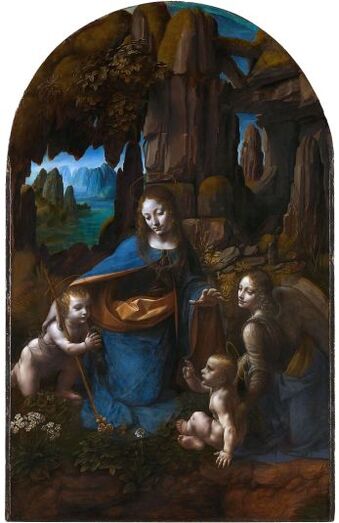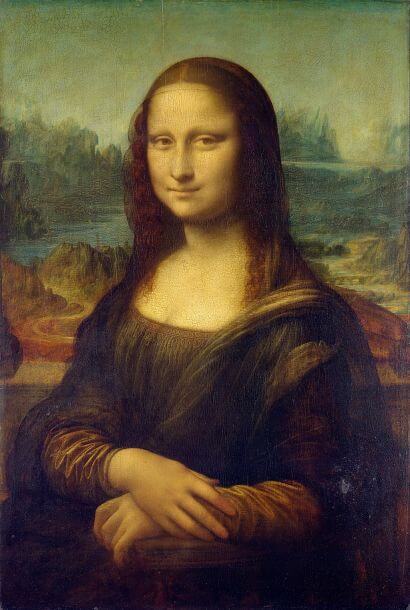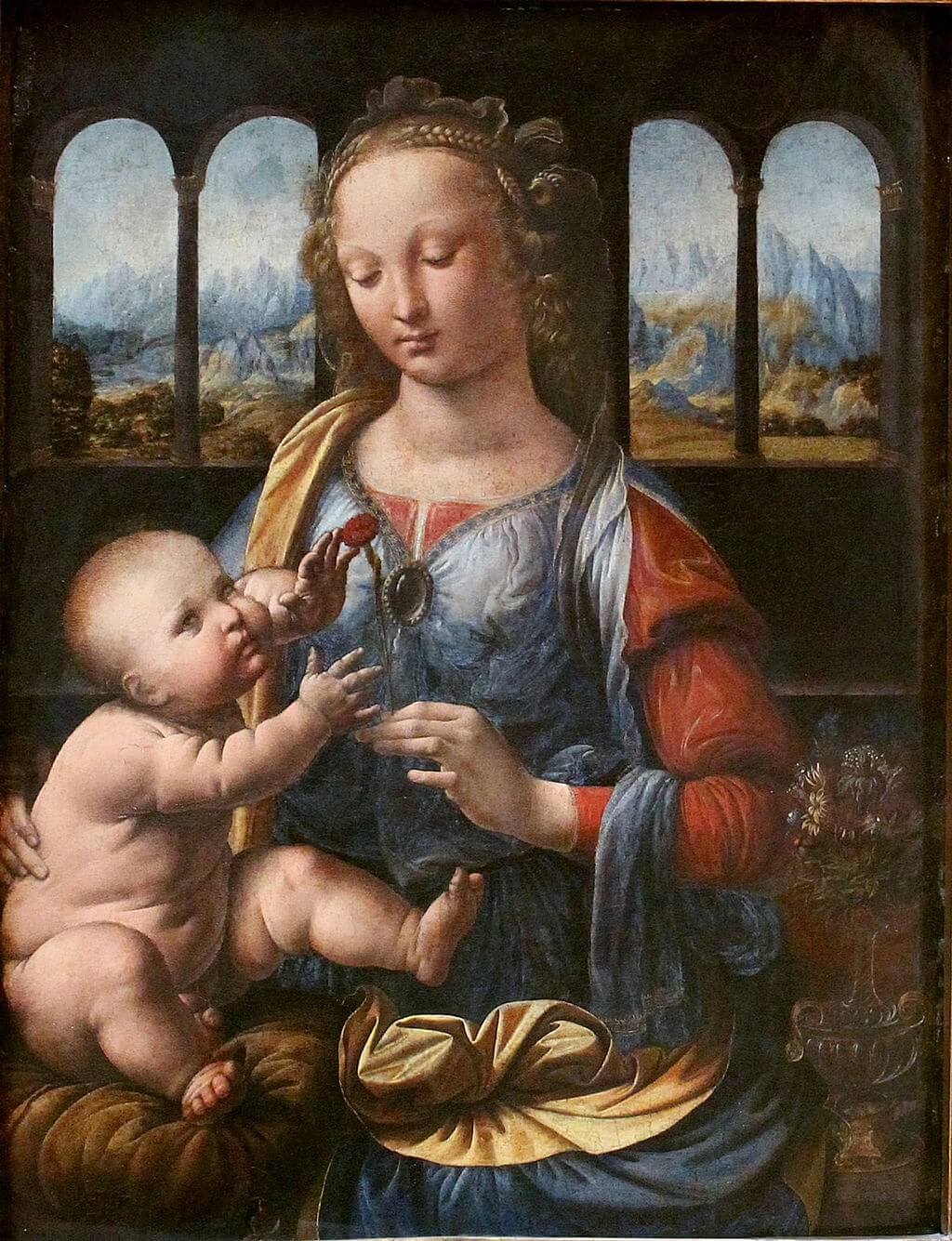Backstory: This painting is called the Madonna Litta because of a previous owner of the painting, the art collector, count Antonio Litta, from Milan, Italy. Tsar Alexander II acquired this painting in 1865 for the Hermitage Museum.
It is not known when Leonardo da Vinci made this painting exactly as he liked to do multiple projects at once and he often took a long time to complete a painting. What is known is that, in 1479, he already completed the first sketch of a nursing Madonna (now in the Royal Library at Windsor, England). After that, he completed more preparatory works for this painting, including a sketch of the face of Mary which is now in the Louvre. It is assumed that Leonardo started this painting in 1481 and that he stopped working on it for a while because of other commissions.
Symbolism: The scene of the Virgin Mary breastfeeding Baby Jesus shows motherhood and motherly love. The blue mantle of Mary symbolizes the Church and her red dress is a symbol of the passion of Christ. The goldfinch is a symbol of the future crucifixion of Jesus. The mountain landscape in the background represents the greatness of the Creation of the world by God.
What is Madonna Lactans? The Virgin Mary breastfeeding Baby Jesus is the perfect example of motherly love. This theme is referred to as Madonna Lactans or Nursing Madonna. Madonna Lactans has been the subject of quite some paintings from the 12th century until the middle of the 16th century when the Council of Trent discouraged the use of nudity in religious paintings. Madonna Lactans was also a frequent theme in the Orthodox Art in Russia, and this theme is better known as Mlekopitatelnitsa. This may explain why the Russian Tsar Alexander II bought this painting for the Hermitage Museum. Who is Leonardo da Vinci? Leonardo di ser Piero da Vinci (1452-1519) was an expert in a large number of different fields, including astronomy, geology, mathematics, music, and painting. He was born in Vinci, near Florence, and received his artistic education in the workshop of Andrea del Verrocchio. During that time, he already created Ginevra de’ Benci, which is in the National Gallery of Art in Washington, DC. After he finished his apprenticeship with Verrocchio in 1478, he moved to Florence, and in 1482 he moved to Milan where he stayed until 1499. There he worked on many different projects, and he often moved on to the next project leaving the previous one unfinished. Over the next decade, he lived in several different places in Italy. During this time, he created his famous Mona Lisa.
Fun fact: There is a lot of debate whether this painting should be attributed to Leonardo da Vinci or one of his assistants. In 1482, Leonardo mentioned that he had completed one Madonna (probably the Benois Madonna, which is also in the Hermitage Museum) and had almost finished another one. This other Madonna can either be the Madonna Litta or the Madonna of the Carnation, which is in the Alte Pinakothek in Munich.
The main reason that people doubt whether this painting is entirely created by Leonardo is the plain landscape, the somewhat dull outfit of Mary, the shadows in this painting, and the lack of details in her face (compare this to Leonardo’s drawing in the Louvre above). People argue that these aspects are not of the quality that we could expect from Leonardo. However, experts agree that the design of the painting and especially the complicated pose of Mary and Baby Jesus could well be from Leonardo. So, it is not unlikely that Leonardo has started this painting, but that an assistant, maybe Giovanni Antonio Boltraffio, finished the painting. Interested in a copy for yourself? Poster.
Written by Eelco Kappe
References:
0 Comments
Leave a Reply. |
Categories
All
|
- Home
- Blog
-
Museums
- Alte Pinakothek
- Art Institute of Chicago
- Baltimore Museum of Art
- Barber Institute of Fine Arts
- Bargello
- Barnes Foundation
- British Museum
- Church of Sant’Anastasia
- Cleveland Museum of Art
- Courtauld Institute of Art
- Detroit Institute of Arts
- Frans Hals Museum
- Galleria Borghese
- Gallerie dell'Accademia
- Getty Museum
- Guggenheim
- Hermitage Museum
- Kunsthistorisches Museum
- Kunstmuseum Basel
- Legion of Honor Museum
- Louvre
- Mauritshuis
- Metropolitan Museum of Art
- Musee d’Orsay
- Museum of Fine Arts in Boston
- Museum of Modern Art
- National Gallery in London
- National Gallery of Art
- National Museum in Poznań
- Norton Simon Museum
- Ny Carlsberg Glyptotek
- Palace of Versailles
- Palazzo Pitti
- Palazzo Vecchio
- Petit Palais
- Philadelphia Museum of Art
- Prado
- Pushkin Museum
- Ravenna Art Museum
- Rijksmuseum
- San Diego Museum of Art
- Santa Maria delle Grazie
- St. Peter's Basilica
- Städel Museum
- Statens Museum for Kunst
- Tate Britain
- Tate Modern
- Timken Museum of Art
- Uffizi
- Vatican Museums
- Wallace Collection
-
Artists
- Altdorfer
- Anguissola
- Berlin Painter
- Bosch
- Botticelli
- Boucher
- Bronzino
- Bruegel the Elder
- Brunelleschi
- Cabanel
- Caillebotte
- Canova
- Caravaggio
- Carpeaux
- Cezanne
- Cimabue
- David
- Degas
- Delacroix
- De Maria
- Donatello
- El Greco
- Fontana
- Fra Angelico
- Fragonard
- Gauguin
- Gentileschi
- Gericault
- Gonzalez-Torres
- Goya
- Hals
- Hogarth
- Hokusai
- Ingres
- Leonardo da Vinci
- Lippi, Filippo
- Longhi, Barbara
- Lorrain
- Makovsky
- Manet
- Massys
- Matisse
- Merian
- Michelangelo
- Mochi
- Modigliani
- Monet
- Panini
- Parmigianino
- Perugino
- Picasso
- Pisanello
- Raphael
- Rembrandt
- Renoir
- Reynolds
- Rivera
- Rodin
- Rubens
- Scultori
- Seurat
- Steen
- Tintoretto
- Titian
- Toulouse-Lautrec
- Turner
- Uccello
- Van der Weyden
- Van Dyck
- Van Eyck
- Van Gogh
- Van Hemessen
- Vasari
- Velazquez
- Vermeer
- Veronese
- Vigée Le Brun
-
Locations
- Books
- About Us







